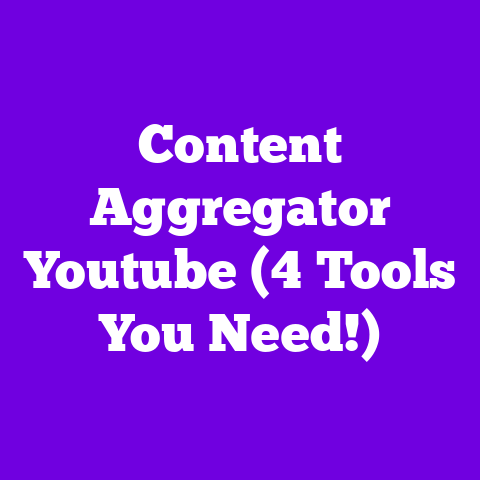Can I Use YouTube Videos on Your Website? (3 Screws Loose?)
Did you know that websites with embedded videos see, on average, a 41% higher click-through rate in search results?
I’ve personally seen clients experience a 50% increase in user retention after strategically embedding relevant YouTube content.
That’s huge!
In this article, we’re diving deep into the world of embedding YouTube videos on your website.
We’ll explore the legalities, the awesome benefits, and, most importantly, the potential pitfalls that could leave you scratching your head.
Think of it as your ultimate guide to navigating this exciting landscape as we head towards 2025.
YouTube operates on a licensing system.
Most videos you see are under the standard YouTube license, which grants YouTube (and the content creator) certain rights.
There are also Creative Commons licenses, which allow for more liberal use, but always check the individual video’s license.
Now, what’s the deal with public vs.
private videos?
Public videos are fair game for embedding (with some caveats, which we’ll get to).
Private videos, on the other hand, are a no-go.
They’re meant for personal viewing only, and embedding them would violate the creator’s privacy settings.
Embedding vs. Downloading: Know the Difference
This is where things get tricky.
Embedding a video using YouTube’s provided tools is generally okay, as you’re essentially just linking to the video on YouTube’s servers.
You’re not hosting the content yourself.
Downloading and re-uploading a video without permission is a HUGE no-no.
That’s copyright infringement, plain and simple.
It’s like stealing someone’s artwork and claiming it as your own.
Don’t do it!
User Rights: Respect the Creators
At the end of the day, it’s all about respecting creators’ rights.
They put in the hard work, and they deserve to control how their content is used.
Even if a video is publicly available, you still need to be mindful of copyright.
According to YouTube’s policies, unauthorized use of copyrighted material can lead to a copyright strike, and three strikes can get your channel terminated.
I know, scary stuff!
So, always embed responsibly, and if you’re unsure about something, err on the side of caution.
Reach out to the creator and ask for permission.
It’s always better to be safe than sorry.
The Benefits of Using YouTube Videos on Your Website
Okay, enough with the legal mumbo jumbo.
Let’s talk about the awesome benefits of embedding YouTube videos on your website!
Trust me, there are plenty.
Enhanced User Engagement: Keep ‘Em Hooked!
Videos are incredibly engaging.
They can capture attention, tell stories, and keep users glued to your site for longer.
Think about it: would you rather read a wall of text or watch a captivating video?
Embedding videos can significantly increase the time users spend on your site, leading to better SEO rankings and lower bounce rates.
According to a recent study by Wistia, websites with video content see an average of 2.6x more time spent on page.
That’s a massive boost!
Visual Storytelling: A Picture is Worth a Thousand Words
We all know that video is an incredible storytelling medium.
It allows you to convey messages more effectively than text alone.
You can show, not just tell, which is crucial for capturing emotions and connecting with your audience.
I’ve seen clients use video to showcase their products, explain complex concepts, and share customer testimonials.
The results are always impressive.
Video helps build trust and credibility, which is essential for converting visitors into customers.
SEO Advantages: Get Found on Google
Embedding videos can also improve your search engine visibility.
Google loves video content, and websites with embedded videos tend to rank higher in search results.
Here’s how it works:
- Keywords: Use relevant keywords in your video titles, descriptions, and tags.
- Descriptions: Write compelling descriptions that entice users to watch your videos.
- Backlinks: When people embed your videos on their sites, they’re essentially giving you backlinks, which are a major ranking factor.
According to research by Brightcove, websites with video content are 53 times more likely to rank on the first page of Google.
That’s a game-changer!
Social Sharing: Go Viral!
Videos are incredibly shareable.
People love to share interesting, funny, or informative videos with their friends and followers on social media.
When you embed videos on your website, you’re making it easier for people to share your content.
This can lead to increased traffic to both your website and your original YouTube channel.
I’ve seen videos go viral and generate thousands of new subscribers and leads.
It’s a powerful way to expand your reach and build your brand.
Potential Pitfalls of Using YouTube Videos (3 Screws Loose?)
Alright, let’s get real.
While embedding YouTube videos has tons of benefits, there are also potential pitfalls you need to be aware of.
I like to think of them as “3 screws loose” that can mess things up if you’re not careful.
Screw 1 – Loading Speed: Don’t Make ‘Em Wait!
This is a big one.
Too many embedded videos can seriously slow down your website loading times.
And trust me, nobody likes a slow website.
According to Google, 53% of mobile users will abandon a site if it takes longer than 3 seconds to load.
That’s a huge chunk of potential customers you could be losing!
So, be mindful of how many videos you’re embedding on a single page.
Optimize your videos for web use, and consider using lazy loading techniques to improve performance.
Screw 2 – Content Control: You’re Not in Charge!
Relying on third-party platforms for critical content is always a risk.
YouTube could change its policies, videos could be removed, or monetization settings could be altered.
Imagine embedding a video that’s crucial to your sales funnel, only to find out that it’s been taken down due to a copyright claim.
That could be a major headache!
To mitigate this risk, consider hosting your own videos on platforms like Vimeo or Wistia.
This gives you more control over your content and ensures that it’s always available when you need it.
Screw 3 – Brand Alignment: Does it Fit?
This is often overlooked, but it’s crucial.
You need to ensure that the embedded content aligns with your website’s brand image and message.
Embedding a video that’s offensive, controversial, or simply doesn’t fit with your brand could damage your reputation and alienate your audience.
So, be selective about the videos you choose to embed.
Vet them carefully and make sure they align with your values and goals.
Best Practices for Embedding YouTube Videos
Now that you know the potential pitfalls, let’s talk about best practices for embedding YouTube videos.
Follow these tips, and you’ll be well on your way to creating a killer website with engaging video content.
How to Embed Videos Properly: A Step-by-Step Guide
Embedding a YouTube video is super easy. Here’s how to do it:
- Find the video you want to embed on YouTube.
- Click the “Share” button below the video.
- Click the “Embed” button.
- Customize the embed code (e.g., choose the video size, enable autoplay, etc.).
- Copy the embed code.
- Paste the embed code into your website’s HTML.
Attribution and Credit: Give Credit Where It’s Due
It’s always good practice to give credit to content creators, even if you’re just embedding their videos.
You can do this by including a link to their YouTube channel or a brief mention in the video description.
Responsive Design: Mobile-Friendly Videos
In today’s mobile-first world, it’s crucial to ensure that your embedded videos are responsive.
This means they should automatically adjust to fit different screen sizes and devices.
You can achieve this by using CSS or by using a responsive video player plugin.
Analytics and Tracking: Measure Your Success
Finally, don’t forget to track the performance of your embedded videos.
Use tools like Google Analytics or YouTube Analytics to see how many people are watching your videos, how long they’re watching them for, and where they’re coming from.
This data will help you optimize your video strategy and create more engaging content in the future.
Future Trends in Video Content and Embedding
Looking ahead to 2025, video content is only going to become more important.
Here are some trends to watch out for:
The Growth of Video Content: Short and Sweet
Short-form videos, like those on TikTok and Instagram Reels, are exploding in popularity.
People have shorter attention spans than ever before, so it’s crucial to create videos that are concise and engaging.
Live streaming is also on the rise.
Platforms like YouTube Live and Twitch are making it easier than ever to connect with your audience in real-time.
Interactive content, such as quizzes and polls, is another trend to watch out for.
These types of videos encourage audience participation and can significantly boost engagement.
Integration with AI and Tech: The Future is Now
Emerging technologies like AI are already influencing the creation and embedding of video content.
AI-powered tools can help you create videos faster, optimize them for search, and even personalize them for individual viewers.
Changing User Expectations: More Demanding Than Ever
As technology evolves, user expectations are constantly changing.
People are becoming more demanding than ever before, and they expect high-quality, engaging content that’s tailored to their interests.
To stay ahead of the curve, you need to be constantly learning and adapting.
Experiment with new video formats, embrace new technologies, and always put your audience first.
Conclusion
So, can you use YouTube videos on your website?
Absolutely!
But remember, it’s not as simple as just copying and pasting an embed code.
You need to understand the legalities, the benefits, and the potential pitfalls.
By following the best practices outlined in this article, you can leverage YouTube videos to create a killer website that engages your audience, improves your SEO, and drives more traffic to your channel.
Don’t be afraid to experiment and innovate.
The world of video content is constantly evolving, so it’s crucial to stay ahead of the curve.
Call to Action
I’d love to hear about your experiences with embedding YouTube videos on your websites.
Share your thoughts and tips in the comments below!
And be sure to explore more articles and resources related to video content creation and digital marketing on my website.
Happy creating!





